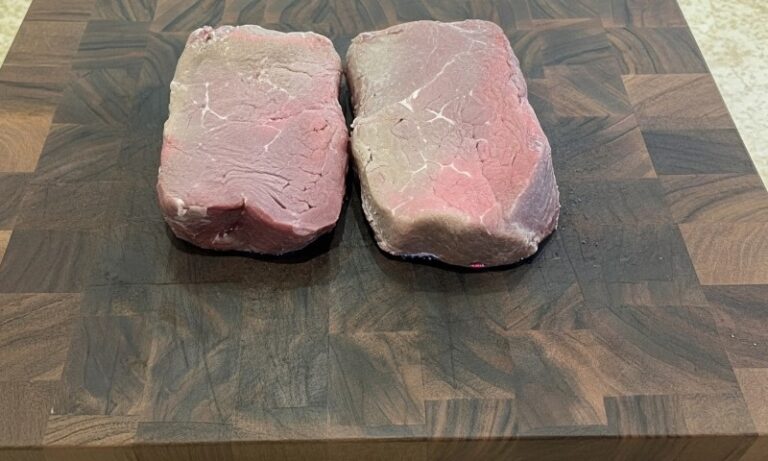Few foods inspire the same mix of craving and caution as a steak. You pull it from the fridge, notice a little brown along the edges, and suddenly you’re second-guessing everything. Is it fine? Did it turn overnight? Should it go on the grill or straight to the bin?
Color can play tricks on even the most careful home cook. A steak that looks dull purple when first opened can bloom into a deep cherry red in minutes.
A bit of brown may be nothing more than oxygen chemistry doing its thing. What actually matters is knowing when color means oxidation, and when it’s a genuine warning sign of spoilage.
Here’s a guide to judging steak safety, built around the checks that never fail: look, smell, feel, and time.
A Quick Look
| Check | Normal Behavior | Red Flag |
| Color | Purplish or brown from oxidation | Green, black, fuzzy growth |
| Smell | Faintly meaty, neutral | Sour, putrid, ammonia-like |
| Texture | Moist and springy | Slimy, sticky, tacky |
| Storage Time (Fridge) | 3–5 days for raw steak | Over 5 days without freezing |
| Storage Time (Freezer) | 4–12 months best quality | Indefinite safety at 0 °F but quality fades |
| Cooking Temp | 145 °F / 63 °C, rest 3 min | Lower temps risk pathogens |
Why Steak Changes Color and Why That’s Usually Okay
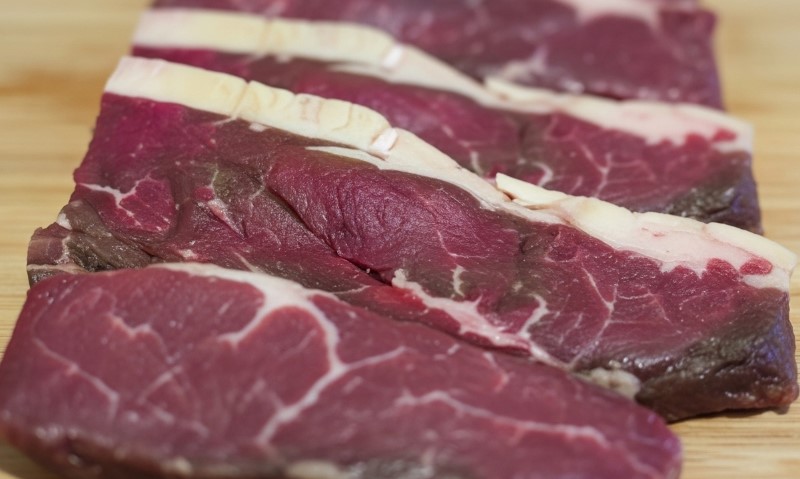
Beef owes its hue to a pigment called myoglobin, which reacts differently depending on how much oxygen it’s exposed to:
- Deoxymyoglobin – Low oxygen; appears purplish (common in vacuum-sealed packs).
- Oxymyoglobin – Oxygenated; turns bright red within minutes of exposure to air, known as “bloom.”
- Metmyoglobin – Oxidized; looks brown or grayish after longer storage or limited airflow.
All three forms are part of normal meat chemistry. They don’t automatically indicate danger. The key is pairing visual cues with smell and touch.
Rainbow Sheen on Cooked or Sliced Meat
Sometimes you’ll notice a green or rainbow shimmer on roast beef or cold cuts. It’s caused by light diffraction off muscle fibers, not by bacteria. Unless it’s paired with a sour smell or sticky surface, it’s harmless.
The Three Tests That Never Fail
When you’re unsure about a steak’s freshness, your senses are the best tools you’ve got. Three simple checks: look, smell, and feel, never miss.
1. Look
Normal signs:
- A steak that’s purple straight out of the vacuum pack and turns red after 10–20 minutes of air exposure.
- Even brown coloring without slime or odor – likely oxidation, not spoilage.
Warning signs:
- Green or black patches.
- Mold or fuzzy spots.
- Dull gray or brown areas paired with off-odors or a slimy feel.
Color alone won’t tell you the full story, so move on to the next test.
2. Smell
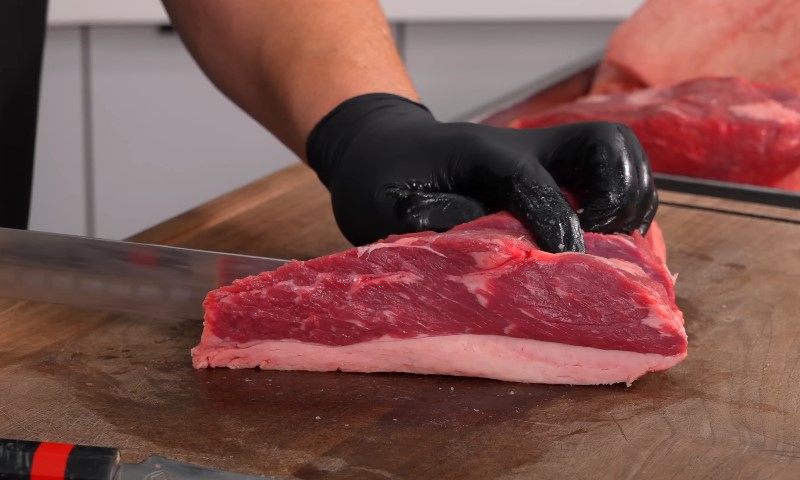
Normal:
A clean, faintly meaty scent or a brief “confinement odor” that fades after you open vacuum packaging.
Spoiled:
A sour, rotten, ammonia-like, or sweetly rancid smell that persists. If the odor hits you before the package is fully open, it’s a clear no-go.
Sometimes vacuum packs swell with gas due to spoilage microbes – another reason to discard.
3. Feel
Safe texture:
Smooth, moist surface that springs back when pressed.
Spoiled texture:
Sticky, slimy, or tacky film that coats your fingers. If the steak clings to your skin like glue or feels slick rather than moist, it’s past saving.
Special Cases (Vacuum-Sealed and Aged Beef)
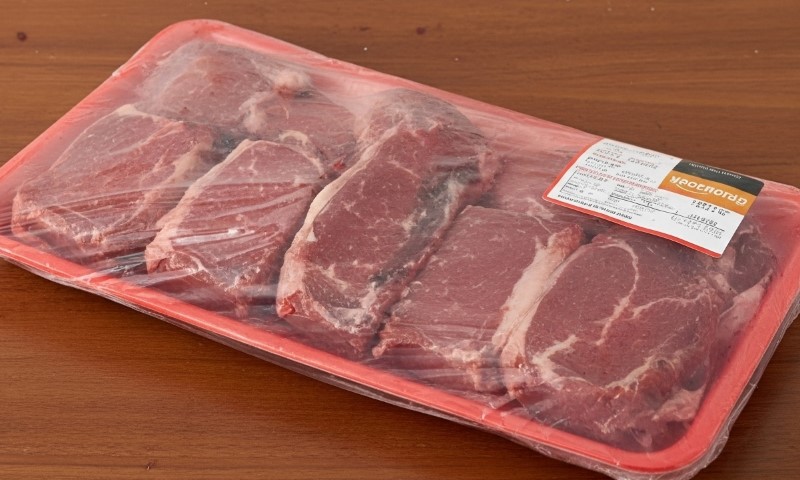
Some steaks come with quirks that can throw you off at first glance. Vacuum-sealed and aged cuts often look or smell different from fresh ones, but most of those changes are harmless once you know what’s normal.
Vacuum-Sealed Steaks
When you open a vacuum-sealed pack, you might catch a quick whiff of sulfur or tangy lactic acid. That’s normal.
Lactic acid bacteria thrive in low-oxygen environments and create mild byproducts that fade as the steak breathes.
If the odor lingers, the pack feels bloated, or the surface seems sticky, discard it. Don’t risk it for a discount steak.
Wet-Aged or Dry-Aged Steaks
Aging develops deep flavor under controlled conditions. It’s not something you can safely reproduce at home without precise temperature and humidity.
Wet-aged steaks can smell mildly funky or nutty, which is fine. But if you notice a rotten or overly sour odor after unsealing, that’s not “aged character” – it’s spoilage.
Storage Rules That Keep Steak Safe
Even the freshest cut can turn risky if it’s stored carelessly. Keeping steak safe is all about controlling time, temperature, and air exposure.
Refrigerator and Freezer Timelines
| Type | Refrigerator (≤ 40 °F / 4 °C) | Freezer (0 °F / −18 °C) |
| Raw steak | 3–5 days | 4–12 months for best quality |
| Cooked steak | 3–4 days | 2–6 months for best quality |
Frozen meat kept constantly at 0 °F remains safe indefinitely, but expect gradual texture and flavor decline over time.
Thawing Safely
Best option: In the refrigerator on a tray to catch drips.
Once thawed, cook within 3-5 days.
Faster Options
- In cold water, sealed in a leak-proof bag, changing water every 30 minutes. Cook immediately afterward.
- In the microwave, using the defrost function. Cook right away after thawing.
Never thaw at room temperature.
Temperature Control and the Two-Hour Rule
- Keep your fridge at or below 40 °F / 4 °C .
- Keep your freezer at 0 °F / −18 °C .
- Never leave raw or cooked steak in the danger zone (40–140 °F / 4–60 °C) for more than 2 hours – or 1 hour if outdoor temps exceed 90 °F / 32 °C.
Power Outages and Safe Recovery
A full freezer can stay safely cold for about 48 hours if unopened; 24 hours if half full.
Discard anything that has stayed above 40 °F longer than two hours once power returns.
Reading the Dates on Steak Labels
| Label | Meaning | What It Tells You |
| Sell-By | For store rotation | Not a safety deadline |
| Use-By / Best-By | Manufacturer’s quality estimate | Quality, not absolute safety |
| Pack Date | When it was packaged | Helpful for tracking freshness at home |
If you’ve kept the steak consistently cold and it smells and feels normal, a date alone doesn’t automatically mean it’s unsafe. But if you’re unsure, always choose safety and discard.
Cooking for Safety and Quality
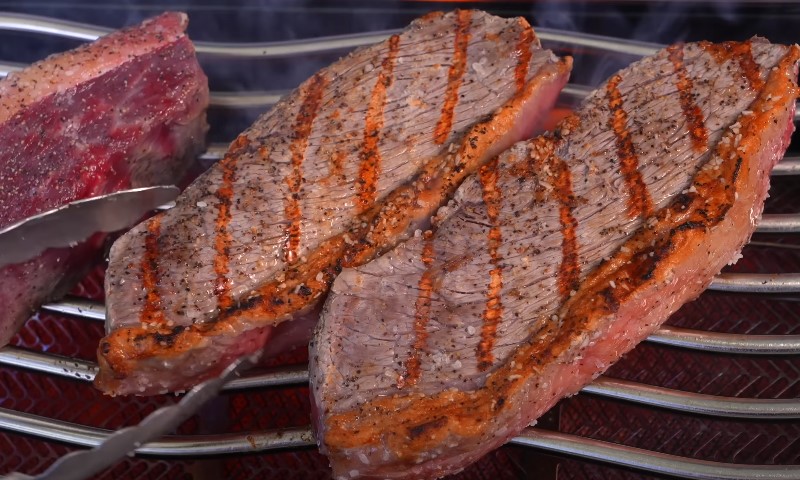
- Cook whole steaks to an internal temperature of 145 °F / 63 °C .
- Let them rest for 3 minutes before serving to allow carryover heat to destroy pathogens.
- For ground beef or mechanically tenderized steaks , cook to 160 °F / 71 °C , since bacteria can spread inside the meat.
- Never rely on color for doneness. Use a food thermometer inserted sideways into the thickest part.
When Oxidation Is Fine and When Spoilage Wins
| Scenario | What You See | What You Smell | What You Feel | Verdict |
| Opened vacuum pack; steak purple | Turns red after 10–20 min | Faint tang that fades | Moist, firm | Safe – normal bloom |
| Steak left uncovered overnight | Brown edges | Neutral | Slightly dry | Safe if within 3–5 days; trim and cook |
| Discount steak near sell-by | Brown patches | Clean | Firm | Safe if kept cold; cook soon |
| Package has strong sour odor | Any color | Sour or rotten | Slimy | Spoiled – discard |
| Freezer-burned area | Gray-white dry patch | Neutral | Leathery | Safe but poor quality; trim |
Safe Shopping, Storing, and Prep
View this post on Instagram
Good habits start before the steak hits your pan. From the grocery aisle to your fridge and cutting board, a few small steps make the difference between a safe meal and a risky one.
At the Store
- Pick up meat last before checkout.
- Make sure packages are cold, sealed, and without tears.
- Use insulated bags or coolers if you have a long trip home.
At Home
- Refrigerate immediately at 40 °F / 4 °C or below.
- Freeze anything you won’t cook within 3–5 days.
- Use airtight wrapping or vacuum sealing for long storage to prevent freezer burn.
Thawing Again (Quick Reminder)
Thaw in the fridge, not on the counter. If you use cold water, keep it moving and cook right away.
Preventing Cross-Contamination
- Keep raw meat separate from fruits, veggies, and cooked foods.
- Wash hands, cutting boards, and knives with hot, soapy water after contact.
- Use color-coded boards if you handle different foods often.
Cooking and Serving
- Use a food thermometer. Guessing by color or juice is unreliable.
- Keep cooked steak at 140 °F or hotter until served.
- If you’re serving outdoors, set dishes over gentle heat or use coolers with ice for cold dishes.
Handling Leftovers
- Refrigerate within 2 hours (or 1 hour if hot weather).
- Eat within 3–4 days or freeze for up to 6 months .
- Reheat to 165 °F / 74 °C before eating.
Foodborne Illness by the Numbers
Food poisoning isn’t rare. According to the U.S. Centers for Disease Control and Prevention (CDC), an estimated 48 million Americans get sick from foodborne pathogens every year, leading to 128,000 hospitalizations and 3,000 deaths .
Those numbers justify every bit of caution about time and temperature.
A Simple Decision Tree for Your Kitchen
Sometimes you just need a quick yes-or-no guide before cooking. This simple checklist helps you decide if that steak stays or goes.
1. How long has it been refrigerated?
- ≤ 5 days: continue
- 5 days: discard unless frozen
2. Open the package and wait 10–20 minutes.
- Purple turns red, odor fades: safe
- Strong off-odor remains: discard
3. Touch the surface.
- Moist and springy: cook to 145 °F with rest
- Sticky or slimy: discard
4. After cooking:
- Chill leftovers within 2 hours
- Eat within 3-4 days or freeze
Keeping It Simple
- Color ≠ Safety – Oxidation happens. Smell and feel matter more.
- Temperature Rules Everything – 40 °F cold, 145 °F hot.
- Timing Is Key – 3–5 days in the fridge for raw, 3-4 days for cooked.
- Don’t Guess by Sight – Use a thermometer, not color.
- When in Doubt, Throw It Out – Better a wasted steak than a wasted weekend in bed.
Final Word
Steak doesn’t come with built-in alarms, but your senses, paired with solid food safety rules, are reliable guides. Purple or brown isn’t always bad; it’s chemistry at work. What counts is how the meat smells, feels, and how long it’s been kept cold. The same can be applied on bacon.
Trust those cues, stick to the temperature rules, and you’ll enjoy every bite without second-guessing what’s on your plate.

